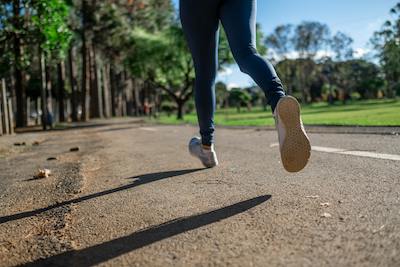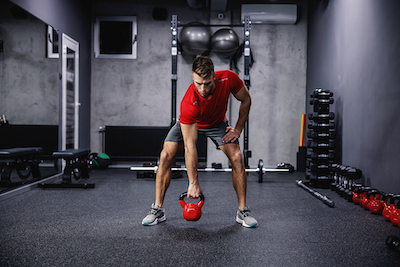Walking and running are two very good cardio exercises. The question of whether you should walk or run depends mainly on your abilities and your goals.
Running is ideal if…
- You want a more intense cardio workout.
- You want to lose weight fast.
- You’re looking for a leaner, more muscular physique.
- You’re already reasonably fit.
Walking is perfect if…
- You are older.
- You haven’t developed the proper running technique yet.
- You’re overweight.
- You’re out of shape.
- You are susceptible to injury.
- You are just starting out.
- You enjoy a less strenuous exercise.
Are you in shape?
Most injuries happen because a person will take on more than they can handle. Before you decide to run, take inventory of your strengths and weaknesses. Are you new to running? Do you already exercise? Do you know how to run (yes, you need proper form to avoid injury)?
Let’s take an example of a middle aged, overweight person who has led a sedentary life for years. Suddenly, they read something that gets them motivated to run. After all, they ran all through their twenties and looked great – it should be easy to pick it up again, right? No, not at all.
During those years of inactivity, fat replaces muscle, endurance falls, and your body’s ability to withstand a high impact activity like running, is minimal. The result? You end up injured. At the very least it’s going to be extremely uncomfortable from a cardio aspect. No one likes to exercise while literally gasping for every breath.
If you’re serious about implementing a running program and you’re out of shape, you need to prepare properly. First, you’ll need to build your cardio and your physical body to prevent injury and build endurance. If you’re overweight, you should get on a diet right now. Imagine how much easier it’ll be without carrying all that excess weight.
One of the best ways to get started is to implement a walking program. Sure, it’s not running, but it will get you going by improving your cardio, building muscle, building endurance, and assisting in weight loss.
No matter what shape you’re in (barring a physical handicap), you can start walking and improve your life. Even if you find a walk around the block challenging, you can start. That’s the beauty of walking – anyone can do it. No excuses.
Proper running technique
Running requires technique to avoid injury. Learn proper form and make sure you build up slowly to avoid the most common injuries such as shin splints and plantar fasciitis. Learn proper running technique here.
Running is a high impact activity and you have to consider the force coming down on your feet. It’s more than twice as much as walking. When you’re walking, one foot is on the ground at all times as opposed to running, which will have you off the ground completely with every stride.
Getting older
If you’re getting up in age, walking is preferred if you want to avoid an injury that might follow you into old age. Oftentimes, we ignore that when we’re older – and just because we know how to prepare for a running routine, doesn’t mean that we should.
Sure, there are plenty of senior runners, but chances are, they have been doing it for decades. I’m not saying you shouldn’t, but in the back of your mind, you should always be wary of venturing beyond your capabilities. At a minimum, check with your doctor and get his/her approval.
Should you walk or run?
Nothing will benefit you like running. If you’ve prepared yourself, a running regime will cause you to lose weight, build muscle, lower cholesterol, lower blood pressure, improve circulation, and strengthen your core.
But, don’t think that walking can’t do that for you also. Maybe not to the same extent, but walking is also a good cardio exercise that does everything running does, just not as fast. In general, it’s a 2-1 ratio. It takes twice as long to get the same benefit if you walk, vs run.
Speed walking
If you’ve been walking for a while, or if you’re in decent shape but aren’t quite ready to start running, you can speed walk if you need a greater challenge.
Speed walking is just a little faster than a normal walking pace. Usually it’s around 3 miles per hour. Make sure you have good shoes that will absorb the harder heel strike.
Power walking
Power walking is faster than speed walking and just below a jog. Force yourself to walk as fast as possible – maximum speed and stride without breaking into a jog. You’ll be averaging around 3-5 miles per hour and this is going to take a lot out of you until you get used to it. On a positive note, you won’t be opening yourself up to injury like jogging or running. Again, good shoes are a must.
Interval training
Once you start jogging/running, you’ll instantly notice a huge uptick in intensity and you are going to feel winded and very out of shape. This is due to the increase in speed and the runners form you will now adopt. Hopefully you’ve learned the proper technique by this time to avoid injury.
Your endurance and cardio have a long way to go and you may not be able to keep it up for long. This is the perfect time to start interval training. Jog until you feel uncomfortable or unable to catch your breath and then start walking to recover. Once your breathing is under control, start jogging again, and so forth. After a time, your cardio will improve to the point where you won’t have to take the walking breaks. If you still want to do internals, sprint instead of jog and then take the walking break as before.
Hills
For a walker, hills are nature’s way of upping the intensity while remaining low impact. If you feel you need a little more than flat walking, try to schedule some hills in your walk. Depending on the pitch, you may even reach or surpass an average runner’s heart rate. Look at it as another form of interval training because what goes up, must come down.
Sometimes walking is enough
You can accomplish more in less time by running. If you walk for 30 minutes, you are getting the same benefit as 15 minutes of running. It’s a 2-1 ratio for the most part. However, not everyone needs this intensity and some of us just like walking.
Walking gets you out exercising and stretching those muscles without the stress that running can bring. Who really enjoys red-lining their heart-rate and gasping for breath? Maybe some do, but for those who appreciate a good walk in the fresh air, there is nothing that comes close. Without feeling like you’re going to pass out, you can enjoy everything else around you and take in your surroundings. Some people even walk to get some deep thinking done. If you’re running and you feel you can’t catch your breath, that’s all you’re concentrating on.
For those who appreciate a good walk, running is not even in the cards. Walking, in this case, is not prep work for running, it is enough in itself. And don’t forget that it is also a good cardio exercise, if not as intense as running.
Consistency
Nothing outperforms consistency. Even if you walk, you are going to outperform a runner who is not as consistent.
Maintaining consistency is the most important thing when it comes to your fitness goals (whether you are a walker or runner). Nothing comes close.
Walkers might be more consistent because walking is low stress and enjoyable.
Final thoughts
- Running may burn more calories afterwards because you brought your heart rate up that much more.
- Running is riskier because it really gets your heart pumping. You have to be sure your body can handle a more intense cardio workout – consult your doctor ahead of time if there is any doubt.
- Running requires a certain level of fitness
- Running helps you lose weight quicker.
- Running is a high intensity activity and walking is moderate intensity. Both are excellent cardiovascular exercises.
- Running results in quicker weight loss for most people. More calories burned – simple chemistry/biology.
- Walking can be started at most any fitness level.
- Walking is less likely to result in injury.
- Just about anyone can walk.
- When it comes to avoiding injury, just use a little common sense. The number one cause of injury is trying to do more than you’re capable of.
- It takes time to build up your endurance and to get in shape. Unless you’re ready, you can get hurt even if you’re not pushing yourself.
- Consistency is more important than whether you walk or run.














